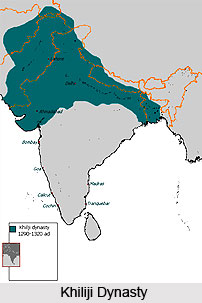The Khiliji ruled over Delhi from 1290 to 1320. Khiljis were basically Central Asians. They had lived in Afganistan for long however, in terms of customs and manners they were different from the Turks.
Malik Firuz, the founder of Khilji dynasty was appointed as `Ariz-I-Mumalik` by Kaiqubad during the declining days of the Slave dynasty. Due to the incompetence of the successors of Balban, a political vacuum was created. Malik Firuz took the advantage of this situation and removed infant Sultan Kaimurs in order to occupy the throne. He took the name Jalal-ud-din Firuz Shah.
 The arrival of the Khiljis was not very much welcomed, as the majority of the Muslim population of Delhi was Turk. But somehow Jalal-ud-din managed to win the heart of the people.
The arrival of the Khiljis was not very much welcomed, as the majority of the Muslim population of Delhi was Turk. But somehow Jalal-ud-din managed to win the heart of the people.
Alauddin Khilji who was the nephew and son-in-law of Jalal-ud-din, killed him. He ascended the throne of Delhi. Alauddin`s reign is considered as the golden era of Khilji rule. His revenue reform and market control policies left a mark. Also the reign was marked by innovative administrative ideas.
Malik Kafur was the most trusted noble of Alauddin. After Alauddin`s death, he managed to control the situation and made Shahab-ud-din Umar. However Malik Kafur`s own agent killed him.
After Malik Kafur, Qutb-ud-din Mubarik Shah another son of Alauddin killed Umar and became the Sultan in1316. During his rule the power was actually in the hands of Khusraw Khan, a lowborn Hindu slave. Mubarik used to spend time in drinking and womanizing. Khusraw killed Mubarik and declared himself as the Sultan. This led to an end of the Khilji Dynasty.
The Islamic architecture in India is an interesting mingling. Marked developments in building techniques were found during the Khilji reign. The third ruler Alauddin was one of the ambitious builders of that time. The Alai Darwaza was an extension of the Qwwat-ul-Islam mosque. This was one of the four grand gateways. Some other structures built by Khiljis were the city wall of Siri, the tomb of Alauddin Khilji and the `Madrasa`. The economic reform by Alaudiin Khilji was undoubtedly a remarkable contribution to the Indian economy. It can be said that the coming of Khaljis to power was more than just being a dynastic change.



















